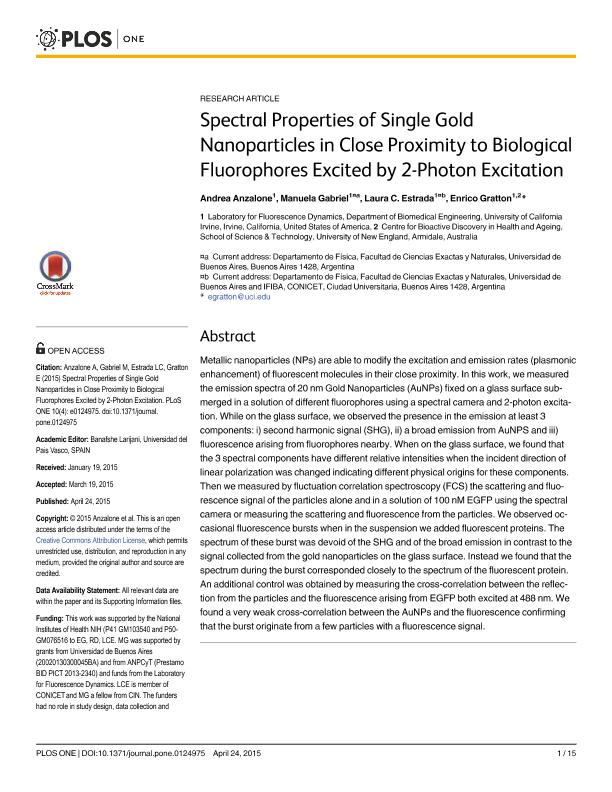Mostrar el registro sencillo del ítem
dc.contributor.author
Anzalone, Andrea
dc.contributor.author
Gabriel, Manuela

dc.contributor.author
Estrada, Laura Cecilia

dc.contributor.author
Gratton, Enrico

dc.date.available
2018-05-24T19:39:52Z
dc.date.issued
2015-04
dc.identifier.citation
Anzalone, Andrea; Gabriel, Manuela; Estrada, Laura Cecilia; Gratton, Enrico; Spectral properties of single gold nanoparticles in close proximity to biological fluorophores excited by 2-photon excitation; Public Library of Science; Plos One; 10; 12; 4-2015; 1-15; e0124975
dc.identifier.issn
1932-6203
dc.identifier.uri
http://hdl.handle.net/11336/46157
dc.description.abstract
Metallic nanoparticles (NPs) are able to modify the excitation and emission rates (plasmonic enhancement) of fluorescent molecules in their close proximity. In this work, we measured the emission spectra of 20 nm Gold Nanoparticles (AuNPs) fixed on a glass surface submerged in a solution of different fluorophores using a spectral camera and 2-photon excitation. While on the glass surface, we observed the presence in the emission at least 3 components: i) second harmonic signal (SHG), ii) a broad emission from AuNPS and iii) fluorescence arising from fluorophores nearby. When on the glass surface, we found that the 3 spectral components have different relative intensities when the incident direction of linear polarization was changed indicating different physical origins for these components. Then we measured by fluctuation correlation spectroscopy (FCS) the scattering and fluorescence signal of the particles alone and in a solution of 100 nM EGFP using the spectral camera or measuring the scattering and fluorescence from the particles. We observed occasional fluorescence bursts when in the suspension we added fluorescent proteins. The spectrum of these burst was devoid of the SHG and of the broad emission in contrast to the signal collected from the gold nanoparticles on the glass surface. Instead we found that the spectrum during the burst corresponded closely to the spectrum of the fluorescent protein. An additional control was obtained by measuring the cross-correlation between the reflection from the particles and the fluorescence arising from EGFP both excited at 488 nm. We found a very weak cross-correlation between the AuNPs and the fluorescence confirming that the burst originate from a few particles with a fluorescence signal.
dc.format
application/pdf
dc.language.iso
eng
dc.publisher
Public Library of Science

dc.rights
info:eu-repo/semantics/openAccess
dc.rights.uri
https://creativecommons.org/licenses/by/2.5/ar/
dc.subject
Nanoparticles
dc.subject
Single Particle Tracking
dc.subject
Microscopy
dc.subject.classification
Otras Ciencias Biológicas

dc.subject.classification
Ciencias Biológicas

dc.subject.classification
CIENCIAS NATURALES Y EXACTAS

dc.title
Spectral properties of single gold nanoparticles in close proximity to biological fluorophores excited by 2-photon excitation
dc.type
info:eu-repo/semantics/article
dc.type
info:ar-repo/semantics/artículo
dc.type
info:eu-repo/semantics/publishedVersion
dc.date.updated
2018-04-27T18:50:20Z
dc.journal.volume
10
dc.journal.number
12
dc.journal.pagination
1-15; e0124975
dc.journal.pais
Estados Unidos

dc.journal.ciudad
San Francisco
dc.description.fil
Fil: Anzalone, Andrea. University of California at Irvine; Estados Unidos
dc.description.fil
Fil: Gabriel, Manuela. Consejo Nacional de Investigaciones Científicas y Técnicas. Oficina de Coordinación Administrativa Ciudad Universitaria. Instituto de Física de Buenos Aires. Universidad de Buenos Aires. Facultad de Ciencias Exactas y Naturales. Instituto de Física de Buenos Aires; Argentina. Universidad de Buenos Aires. Facultad de Ciencias Exactas y Naturales. Departamento de Física. Laboratorio de Electrónica Cuántica; Argentina. University of California at Irvine; Estados Unidos
dc.description.fil
Fil: Estrada, Laura Cecilia. Consejo Nacional de Investigaciones Científicas y Técnicas. Oficina de Coordinación Administrativa Ciudad Universitaria. Instituto de Física de Buenos Aires. Universidad de Buenos Aires. Facultad de Ciencias Exactas y Naturales. Instituto de Física de Buenos Aires; Argentina. Universidad de Buenos Aires. Facultad de Ciencias Exactas y Naturales. Departamento de Física. Laboratorio de Electrónica Cuántica; Argentina. University of California at Irvine; Estados Unidos
dc.description.fil
Fil: Gratton, Enrico. University of California at Irvine; Estados Unidos. University of New England; Australia
dc.journal.title
Plos One

dc.relation.alternativeid
info:eu-repo/semantics/altIdentifier/doi/http://dx.doi.org/10.1371/journal.pone.0124975
dc.relation.alternativeid
info:eu-repo/semantics/altIdentifier/url/http://journals.plos.org/plosone/article?id=10.1371/journal.pone.0124975
Archivos asociados
